Cultural & Micro-Cultural Impact on Nestle's Marketing Campaigns
VerifiedAdded on 2023/06/03
|16
|5901
|193
Report
AI Summary
This report provides a comprehensive analysis of Nestle's marketing strategies in the United States, India, and Australia, highlighting the differences in their campaigns and the adjustments made to accommodate cultural nuances and micro-cultural influences. It explores how factors like individualism, family values, and demographic features shape Nestle's marketing approach in each country. The report also addresses the impact of cultural diversity on marketing strategies, focusing on the role of symbols, rituals, and thought processes. Additionally, it discusses the potential downsides of marketing in different cultural contexts, such as consumer preferences for genetically engineered foods or the need to align with local values and sentiments. The analysis draws upon various marketing concepts to explain the complexities of international marketing and the importance of adapting strategies to suit specific cultural environments. This report showcases the critical role of cultural understanding in ensuring the success of global marketing campaigns.
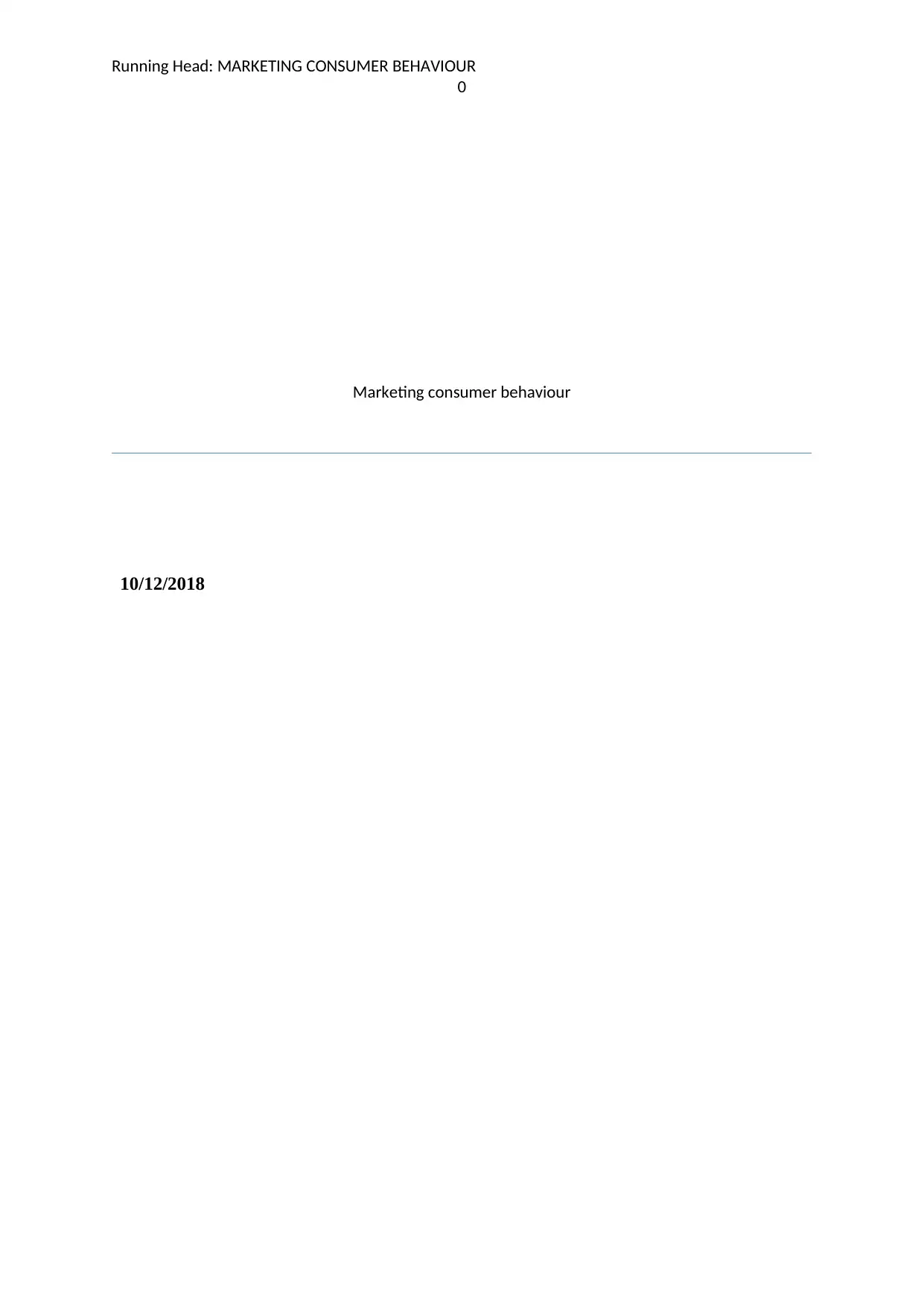
Running Head: MARKETING CONSUMER BEHAVIOUR
0
Marketing consumer behaviour
10/12/2018
0
Marketing consumer behaviour
10/12/2018
Paraphrase This Document
Need a fresh take? Get an instant paraphrase of this document with our AI Paraphraser
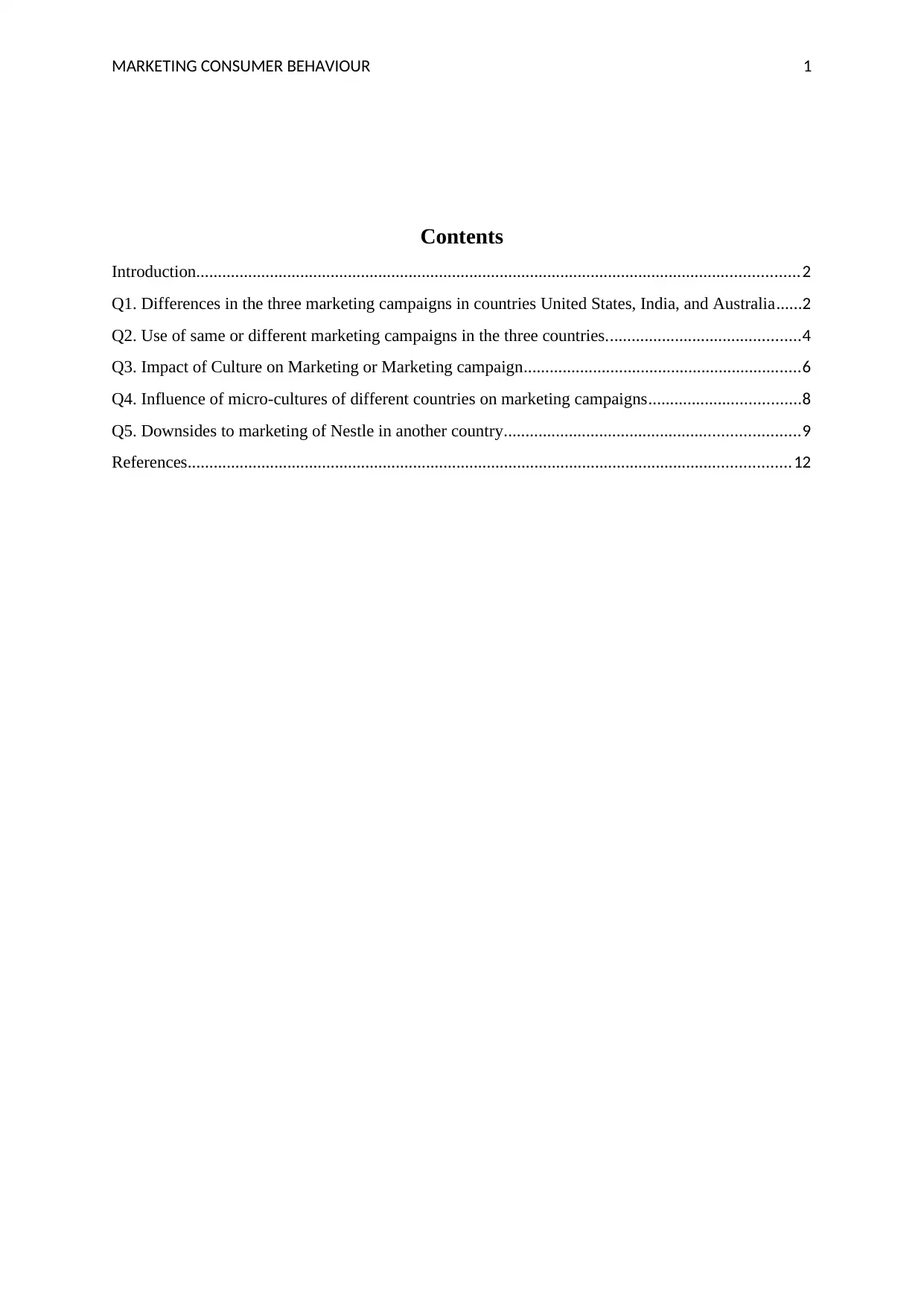
MARKETING CONSUMER BEHAVIOUR 1
Contents
Introduction...........................................................................................................................................2
Q1. Differences in the three marketing campaigns in countries United States, India, and Australia......2
Q2. Use of same or different marketing campaigns in the three countries.............................................4
Q3. Impact of Culture on Marketing or Marketing campaign................................................................6
Q4. Influence of micro-cultures of different countries on marketing campaigns...................................8
Q5. Downsides to marketing of Nestle in another country....................................................................9
References...........................................................................................................................................12
Contents
Introduction...........................................................................................................................................2
Q1. Differences in the three marketing campaigns in countries United States, India, and Australia......2
Q2. Use of same or different marketing campaigns in the three countries.............................................4
Q3. Impact of Culture on Marketing or Marketing campaign................................................................6
Q4. Influence of micro-cultures of different countries on marketing campaigns...................................8
Q5. Downsides to marketing of Nestle in another country....................................................................9
References...........................................................................................................................................12
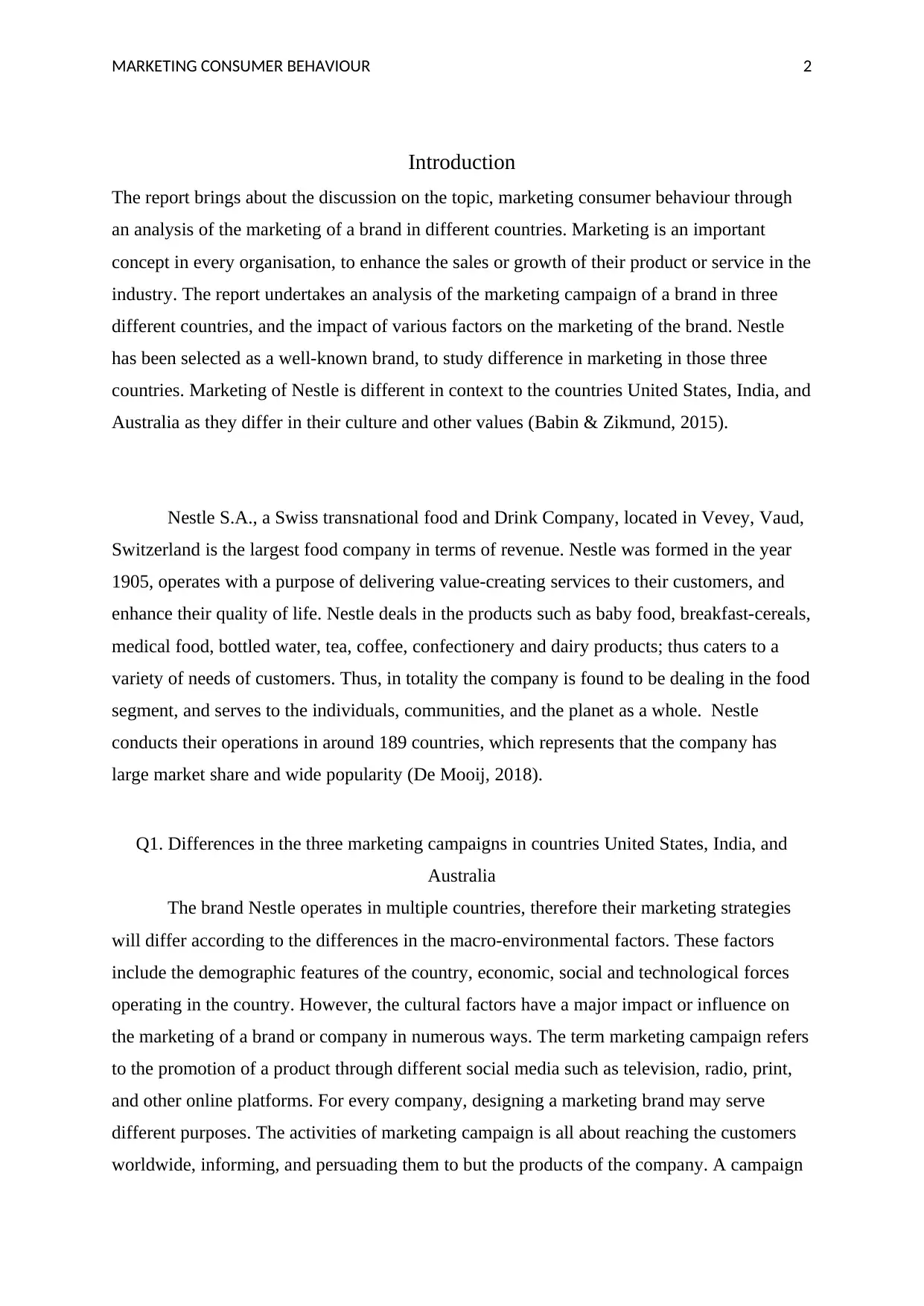
MARKETING CONSUMER BEHAVIOUR 2
Introduction
The report brings about the discussion on the topic, marketing consumer behaviour through
an analysis of the marketing of a brand in different countries. Marketing is an important
concept in every organisation, to enhance the sales or growth of their product or service in the
industry. The report undertakes an analysis of the marketing campaign of a brand in three
different countries, and the impact of various factors on the marketing of the brand. Nestle
has been selected as a well-known brand, to study difference in marketing in those three
countries. Marketing of Nestle is different in context to the countries United States, India, and
Australia as they differ in their culture and other values (Babin & Zikmund, 2015).
Nestle S.A., a Swiss transnational food and Drink Company, located in Vevey, Vaud,
Switzerland is the largest food company in terms of revenue. Nestle was formed in the year
1905, operates with a purpose of delivering value-creating services to their customers, and
enhance their quality of life. Nestle deals in the products such as baby food, breakfast-cereals,
medical food, bottled water, tea, coffee, confectionery and dairy products; thus caters to a
variety of needs of customers. Thus, in totality the company is found to be dealing in the food
segment, and serves to the individuals, communities, and the planet as a whole. Nestle
conducts their operations in around 189 countries, which represents that the company has
large market share and wide popularity (De Mooij, 2018).
Q1. Differences in the three marketing campaigns in countries United States, India, and
Australia
The brand Nestle operates in multiple countries, therefore their marketing strategies
will differ according to the differences in the macro-environmental factors. These factors
include the demographic features of the country, economic, social and technological forces
operating in the country. However, the cultural factors have a major impact or influence on
the marketing of a brand or company in numerous ways. The term marketing campaign refers
to the promotion of a product through different social media such as television, radio, print,
and other online platforms. For every company, designing a marketing brand may serve
different purposes. The activities of marketing campaign is all about reaching the customers
worldwide, informing, and persuading them to but the products of the company. A campaign
Introduction
The report brings about the discussion on the topic, marketing consumer behaviour through
an analysis of the marketing of a brand in different countries. Marketing is an important
concept in every organisation, to enhance the sales or growth of their product or service in the
industry. The report undertakes an analysis of the marketing campaign of a brand in three
different countries, and the impact of various factors on the marketing of the brand. Nestle
has been selected as a well-known brand, to study difference in marketing in those three
countries. Marketing of Nestle is different in context to the countries United States, India, and
Australia as they differ in their culture and other values (Babin & Zikmund, 2015).
Nestle S.A., a Swiss transnational food and Drink Company, located in Vevey, Vaud,
Switzerland is the largest food company in terms of revenue. Nestle was formed in the year
1905, operates with a purpose of delivering value-creating services to their customers, and
enhance their quality of life. Nestle deals in the products such as baby food, breakfast-cereals,
medical food, bottled water, tea, coffee, confectionery and dairy products; thus caters to a
variety of needs of customers. Thus, in totality the company is found to be dealing in the food
segment, and serves to the individuals, communities, and the planet as a whole. Nestle
conducts their operations in around 189 countries, which represents that the company has
large market share and wide popularity (De Mooij, 2018).
Q1. Differences in the three marketing campaigns in countries United States, India, and
Australia
The brand Nestle operates in multiple countries, therefore their marketing strategies
will differ according to the differences in the macro-environmental factors. These factors
include the demographic features of the country, economic, social and technological forces
operating in the country. However, the cultural factors have a major impact or influence on
the marketing of a brand or company in numerous ways. The term marketing campaign refers
to the promotion of a product through different social media such as television, radio, print,
and other online platforms. For every company, designing a marketing brand may serve
different purposes. The activities of marketing campaign is all about reaching the customers
worldwide, informing, and persuading them to but the products of the company. A campaign
⊘ This is a preview!⊘
Do you want full access?
Subscribe today to unlock all pages.

Trusted by 1+ million students worldwide
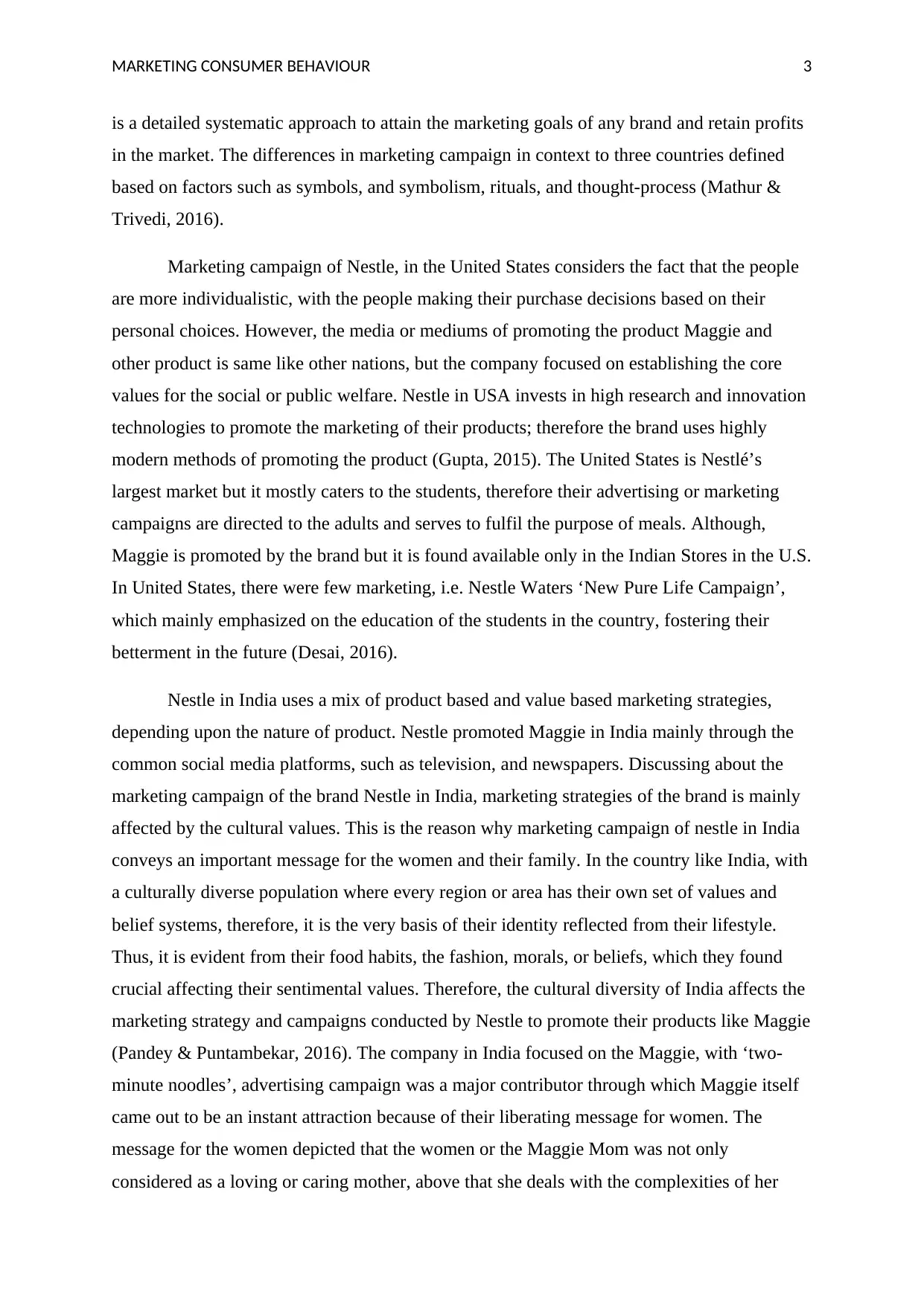
MARKETING CONSUMER BEHAVIOUR 3
is a detailed systematic approach to attain the marketing goals of any brand and retain profits
in the market. The differences in marketing campaign in context to three countries defined
based on factors such as symbols, and symbolism, rituals, and thought-process (Mathur &
Trivedi, 2016).
Marketing campaign of Nestle, in the United States considers the fact that the people
are more individualistic, with the people making their purchase decisions based on their
personal choices. However, the media or mediums of promoting the product Maggie and
other product is same like other nations, but the company focused on establishing the core
values for the social or public welfare. Nestle in USA invests in high research and innovation
technologies to promote the marketing of their products; therefore the brand uses highly
modern methods of promoting the product (Gupta, 2015). The United States is Nestlé’s
largest market but it mostly caters to the students, therefore their advertising or marketing
campaigns are directed to the adults and serves to fulfil the purpose of meals. Although,
Maggie is promoted by the brand but it is found available only in the Indian Stores in the U.S.
In United States, there were few marketing, i.e. Nestle Waters ‘New Pure Life Campaign’,
which mainly emphasized on the education of the students in the country, fostering their
betterment in the future (Desai, 2016).
Nestle in India uses a mix of product based and value based marketing strategies,
depending upon the nature of product. Nestle promoted Maggie in India mainly through the
common social media platforms, such as television, and newspapers. Discussing about the
marketing campaign of the brand Nestle in India, marketing strategies of the brand is mainly
affected by the cultural values. This is the reason why marketing campaign of nestle in India
conveys an important message for the women and their family. In the country like India, with
a culturally diverse population where every region or area has their own set of values and
belief systems, therefore, it is the very basis of their identity reflected from their lifestyle.
Thus, it is evident from their food habits, the fashion, morals, or beliefs, which they found
crucial affecting their sentimental values. Therefore, the cultural diversity of India affects the
marketing strategy and campaigns conducted by Nestle to promote their products like Maggie
(Pandey & Puntambekar, 2016). The company in India focused on the Maggie, with ‘two-
minute noodles’, advertising campaign was a major contributor through which Maggie itself
came out to be an instant attraction because of their liberating message for women. The
message for the women depicted that the women or the Maggie Mom was not only
considered as a loving or caring mother, above that she deals with the complexities of her
is a detailed systematic approach to attain the marketing goals of any brand and retain profits
in the market. The differences in marketing campaign in context to three countries defined
based on factors such as symbols, and symbolism, rituals, and thought-process (Mathur &
Trivedi, 2016).
Marketing campaign of Nestle, in the United States considers the fact that the people
are more individualistic, with the people making their purchase decisions based on their
personal choices. However, the media or mediums of promoting the product Maggie and
other product is same like other nations, but the company focused on establishing the core
values for the social or public welfare. Nestle in USA invests in high research and innovation
technologies to promote the marketing of their products; therefore the brand uses highly
modern methods of promoting the product (Gupta, 2015). The United States is Nestlé’s
largest market but it mostly caters to the students, therefore their advertising or marketing
campaigns are directed to the adults and serves to fulfil the purpose of meals. Although,
Maggie is promoted by the brand but it is found available only in the Indian Stores in the U.S.
In United States, there were few marketing, i.e. Nestle Waters ‘New Pure Life Campaign’,
which mainly emphasized on the education of the students in the country, fostering their
betterment in the future (Desai, 2016).
Nestle in India uses a mix of product based and value based marketing strategies,
depending upon the nature of product. Nestle promoted Maggie in India mainly through the
common social media platforms, such as television, and newspapers. Discussing about the
marketing campaign of the brand Nestle in India, marketing strategies of the brand is mainly
affected by the cultural values. This is the reason why marketing campaign of nestle in India
conveys an important message for the women and their family. In the country like India, with
a culturally diverse population where every region or area has their own set of values and
belief systems, therefore, it is the very basis of their identity reflected from their lifestyle.
Thus, it is evident from their food habits, the fashion, morals, or beliefs, which they found
crucial affecting their sentimental values. Therefore, the cultural diversity of India affects the
marketing strategy and campaigns conducted by Nestle to promote their products like Maggie
(Pandey & Puntambekar, 2016). The company in India focused on the Maggie, with ‘two-
minute noodles’, advertising campaign was a major contributor through which Maggie itself
came out to be an instant attraction because of their liberating message for women. The
message for the women depicted that the women or the Maggie Mom was not only
considered as a loving or caring mother, above that she deals with the complexities of her
Paraphrase This Document
Need a fresh take? Get an instant paraphrase of this document with our AI Paraphraser
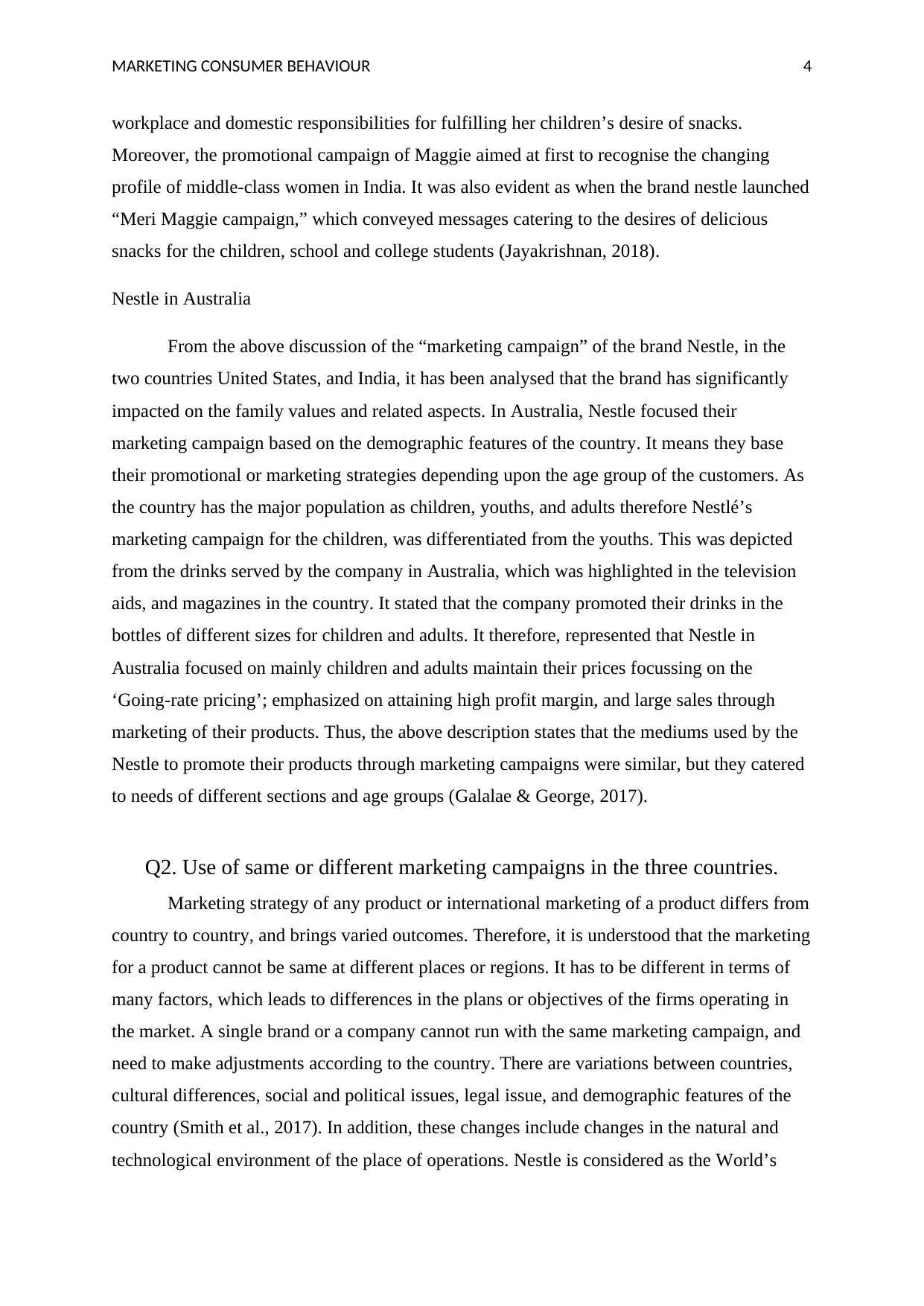
MARKETING CONSUMER BEHAVIOUR 4
workplace and domestic responsibilities for fulfilling her children’s desire of snacks.
Moreover, the promotional campaign of Maggie aimed at first to recognise the changing
profile of middle-class women in India. It was also evident as when the brand nestle launched
“Meri Maggie campaign,” which conveyed messages catering to the desires of delicious
snacks for the children, school and college students (Jayakrishnan, 2018).
Nestle in Australia
From the above discussion of the “marketing campaign” of the brand Nestle, in the
two countries United States, and India, it has been analysed that the brand has significantly
impacted on the family values and related aspects. In Australia, Nestle focused their
marketing campaign based on the demographic features of the country. It means they base
their promotional or marketing strategies depending upon the age group of the customers. As
the country has the major population as children, youths, and adults therefore Nestlé’s
marketing campaign for the children, was differentiated from the youths. This was depicted
from the drinks served by the company in Australia, which was highlighted in the television
aids, and magazines in the country. It stated that the company promoted their drinks in the
bottles of different sizes for children and adults. It therefore, represented that Nestle in
Australia focused on mainly children and adults maintain their prices focussing on the
‘Going-rate pricing’; emphasized on attaining high profit margin, and large sales through
marketing of their products. Thus, the above description states that the mediums used by the
Nestle to promote their products through marketing campaigns were similar, but they catered
to needs of different sections and age groups (Galalae & George, 2017).
Q2. Use of same or different marketing campaigns in the three countries.
Marketing strategy of any product or international marketing of a product differs from
country to country, and brings varied outcomes. Therefore, it is understood that the marketing
for a product cannot be same at different places or regions. It has to be different in terms of
many factors, which leads to differences in the plans or objectives of the firms operating in
the market. A single brand or a company cannot run with the same marketing campaign, and
need to make adjustments according to the country. There are variations between countries,
cultural differences, social and political issues, legal issue, and demographic features of the
country (Smith et al., 2017). In addition, these changes include changes in the natural and
technological environment of the place of operations. Nestle is considered as the World’s
workplace and domestic responsibilities for fulfilling her children’s desire of snacks.
Moreover, the promotional campaign of Maggie aimed at first to recognise the changing
profile of middle-class women in India. It was also evident as when the brand nestle launched
“Meri Maggie campaign,” which conveyed messages catering to the desires of delicious
snacks for the children, school and college students (Jayakrishnan, 2018).
Nestle in Australia
From the above discussion of the “marketing campaign” of the brand Nestle, in the
two countries United States, and India, it has been analysed that the brand has significantly
impacted on the family values and related aspects. In Australia, Nestle focused their
marketing campaign based on the demographic features of the country. It means they base
their promotional or marketing strategies depending upon the age group of the customers. As
the country has the major population as children, youths, and adults therefore Nestlé’s
marketing campaign for the children, was differentiated from the youths. This was depicted
from the drinks served by the company in Australia, which was highlighted in the television
aids, and magazines in the country. It stated that the company promoted their drinks in the
bottles of different sizes for children and adults. It therefore, represented that Nestle in
Australia focused on mainly children and adults maintain their prices focussing on the
‘Going-rate pricing’; emphasized on attaining high profit margin, and large sales through
marketing of their products. Thus, the above description states that the mediums used by the
Nestle to promote their products through marketing campaigns were similar, but they catered
to needs of different sections and age groups (Galalae & George, 2017).
Q2. Use of same or different marketing campaigns in the three countries.
Marketing strategy of any product or international marketing of a product differs from
country to country, and brings varied outcomes. Therefore, it is understood that the marketing
for a product cannot be same at different places or regions. It has to be different in terms of
many factors, which leads to differences in the plans or objectives of the firms operating in
the market. A single brand or a company cannot run with the same marketing campaign, and
need to make adjustments according to the country. There are variations between countries,
cultural differences, social and political issues, legal issue, and demographic features of the
country (Smith et al., 2017). In addition, these changes include changes in the natural and
technological environment of the place of operations. Nestle is considered as the World’s
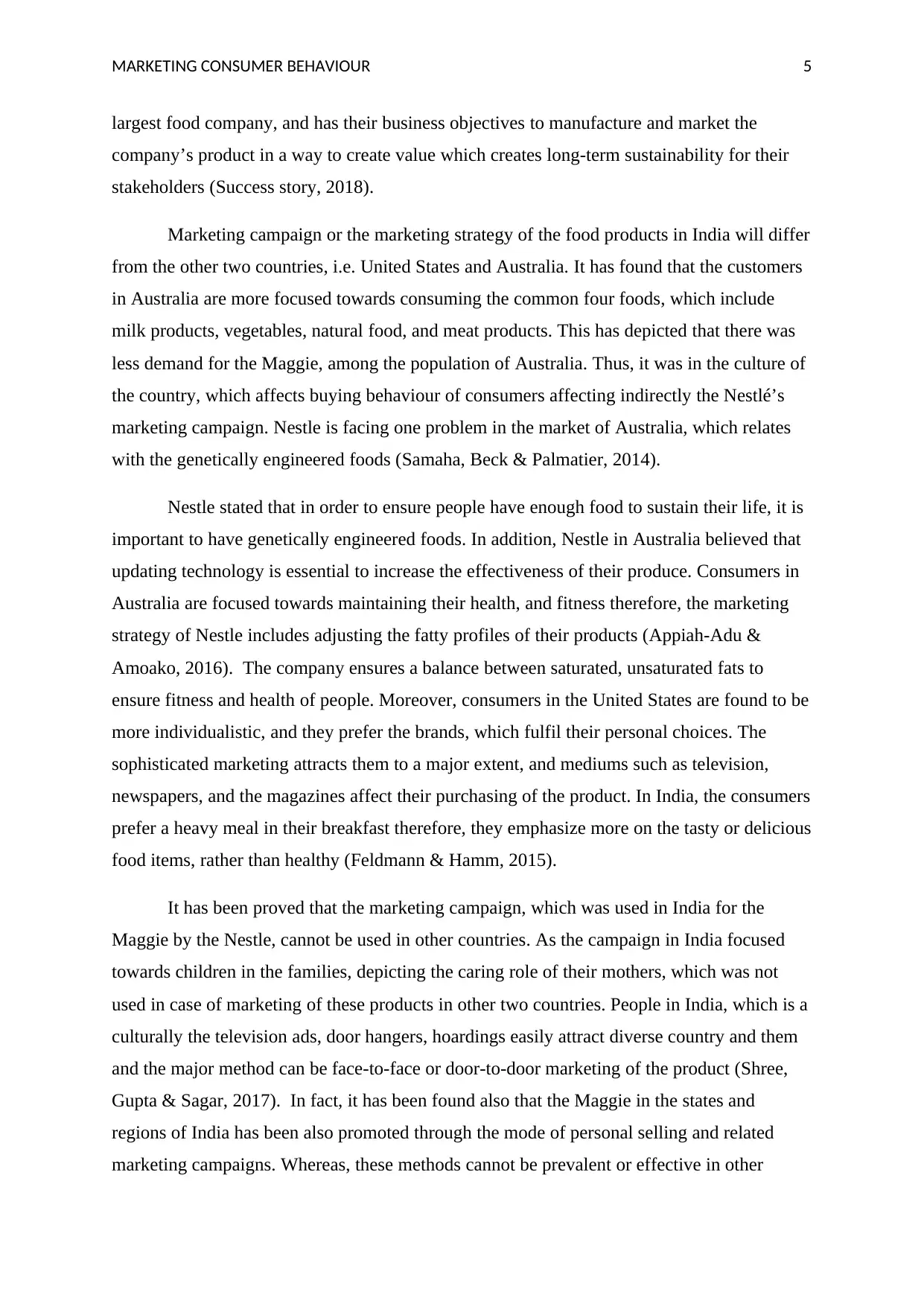
MARKETING CONSUMER BEHAVIOUR 5
largest food company, and has their business objectives to manufacture and market the
company’s product in a way to create value which creates long-term sustainability for their
stakeholders (Success story, 2018).
Marketing campaign or the marketing strategy of the food products in India will differ
from the other two countries, i.e. United States and Australia. It has found that the customers
in Australia are more focused towards consuming the common four foods, which include
milk products, vegetables, natural food, and meat products. This has depicted that there was
less demand for the Maggie, among the population of Australia. Thus, it was in the culture of
the country, which affects buying behaviour of consumers affecting indirectly the Nestlé’s
marketing campaign. Nestle is facing one problem in the market of Australia, which relates
with the genetically engineered foods (Samaha, Beck & Palmatier, 2014).
Nestle stated that in order to ensure people have enough food to sustain their life, it is
important to have genetically engineered foods. In addition, Nestle in Australia believed that
updating technology is essential to increase the effectiveness of their produce. Consumers in
Australia are focused towards maintaining their health, and fitness therefore, the marketing
strategy of Nestle includes adjusting the fatty profiles of their products (Appiah-Adu &
Amoako, 2016). The company ensures a balance between saturated, unsaturated fats to
ensure fitness and health of people. Moreover, consumers in the United States are found to be
more individualistic, and they prefer the brands, which fulfil their personal choices. The
sophisticated marketing attracts them to a major extent, and mediums such as television,
newspapers, and the magazines affect their purchasing of the product. In India, the consumers
prefer a heavy meal in their breakfast therefore, they emphasize more on the tasty or delicious
food items, rather than healthy (Feldmann & Hamm, 2015).
It has been proved that the marketing campaign, which was used in India for the
Maggie by the Nestle, cannot be used in other countries. As the campaign in India focused
towards children in the families, depicting the caring role of their mothers, which was not
used in case of marketing of these products in other two countries. People in India, which is a
culturally the television ads, door hangers, hoardings easily attract diverse country and them
and the major method can be face-to-face or door-to-door marketing of the product (Shree,
Gupta & Sagar, 2017). In fact, it has been found also that the Maggie in the states and
regions of India has been also promoted through the mode of personal selling and related
marketing campaigns. Whereas, these methods cannot be prevalent or effective in other
largest food company, and has their business objectives to manufacture and market the
company’s product in a way to create value which creates long-term sustainability for their
stakeholders (Success story, 2018).
Marketing campaign or the marketing strategy of the food products in India will differ
from the other two countries, i.e. United States and Australia. It has found that the customers
in Australia are more focused towards consuming the common four foods, which include
milk products, vegetables, natural food, and meat products. This has depicted that there was
less demand for the Maggie, among the population of Australia. Thus, it was in the culture of
the country, which affects buying behaviour of consumers affecting indirectly the Nestlé’s
marketing campaign. Nestle is facing one problem in the market of Australia, which relates
with the genetically engineered foods (Samaha, Beck & Palmatier, 2014).
Nestle stated that in order to ensure people have enough food to sustain their life, it is
important to have genetically engineered foods. In addition, Nestle in Australia believed that
updating technology is essential to increase the effectiveness of their produce. Consumers in
Australia are focused towards maintaining their health, and fitness therefore, the marketing
strategy of Nestle includes adjusting the fatty profiles of their products (Appiah-Adu &
Amoako, 2016). The company ensures a balance between saturated, unsaturated fats to
ensure fitness and health of people. Moreover, consumers in the United States are found to be
more individualistic, and they prefer the brands, which fulfil their personal choices. The
sophisticated marketing attracts them to a major extent, and mediums such as television,
newspapers, and the magazines affect their purchasing of the product. In India, the consumers
prefer a heavy meal in their breakfast therefore, they emphasize more on the tasty or delicious
food items, rather than healthy (Feldmann & Hamm, 2015).
It has been proved that the marketing campaign, which was used in India for the
Maggie by the Nestle, cannot be used in other countries. As the campaign in India focused
towards children in the families, depicting the caring role of their mothers, which was not
used in case of marketing of these products in other two countries. People in India, which is a
culturally the television ads, door hangers, hoardings easily attract diverse country and them
and the major method can be face-to-face or door-to-door marketing of the product (Shree,
Gupta & Sagar, 2017). In fact, it has been found also that the Maggie in the states and
regions of India has been also promoted through the mode of personal selling and related
marketing campaigns. Whereas, these methods cannot be prevalent or effective in other
⊘ This is a preview!⊘
Do you want full access?
Subscribe today to unlock all pages.

Trusted by 1+ million students worldwide
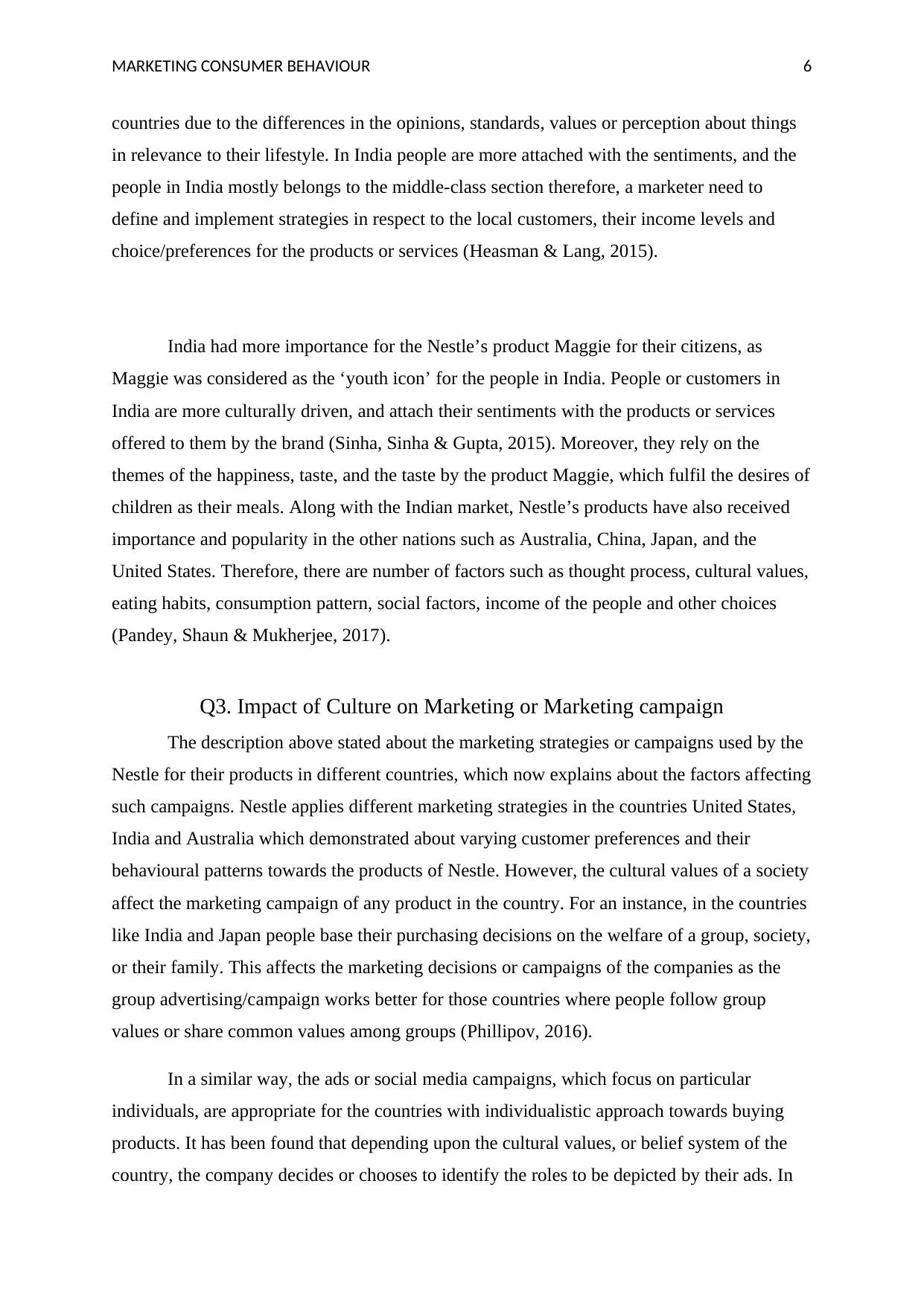
MARKETING CONSUMER BEHAVIOUR 6
countries due to the differences in the opinions, standards, values or perception about things
in relevance to their lifestyle. In India people are more attached with the sentiments, and the
people in India mostly belongs to the middle-class section therefore, a marketer need to
define and implement strategies in respect to the local customers, their income levels and
choice/preferences for the products or services (Heasman & Lang, 2015).
India had more importance for the Nestle’s product Maggie for their citizens, as
Maggie was considered as the ‘youth icon’ for the people in India. People or customers in
India are more culturally driven, and attach their sentiments with the products or services
offered to them by the brand (Sinha, Sinha & Gupta, 2015). Moreover, they rely on the
themes of the happiness, taste, and the taste by the product Maggie, which fulfil the desires of
children as their meals. Along with the Indian market, Nestle’s products have also received
importance and popularity in the other nations such as Australia, China, Japan, and the
United States. Therefore, there are number of factors such as thought process, cultural values,
eating habits, consumption pattern, social factors, income of the people and other choices
(Pandey, Shaun & Mukherjee, 2017).
Q3. Impact of Culture on Marketing or Marketing campaign
The description above stated about the marketing strategies or campaigns used by the
Nestle for their products in different countries, which now explains about the factors affecting
such campaigns. Nestle applies different marketing strategies in the countries United States,
India and Australia which demonstrated about varying customer preferences and their
behavioural patterns towards the products of Nestle. However, the cultural values of a society
affect the marketing campaign of any product in the country. For an instance, in the countries
like India and Japan people base their purchasing decisions on the welfare of a group, society,
or their family. This affects the marketing decisions or campaigns of the companies as the
group advertising/campaign works better for those countries where people follow group
values or share common values among groups (Phillipov, 2016).
In a similar way, the ads or social media campaigns, which focus on particular
individuals, are appropriate for the countries with individualistic approach towards buying
products. It has been found that depending upon the cultural values, or belief system of the
country, the company decides or chooses to identify the roles to be depicted by their ads. In
countries due to the differences in the opinions, standards, values or perception about things
in relevance to their lifestyle. In India people are more attached with the sentiments, and the
people in India mostly belongs to the middle-class section therefore, a marketer need to
define and implement strategies in respect to the local customers, their income levels and
choice/preferences for the products or services (Heasman & Lang, 2015).
India had more importance for the Nestle’s product Maggie for their citizens, as
Maggie was considered as the ‘youth icon’ for the people in India. People or customers in
India are more culturally driven, and attach their sentiments with the products or services
offered to them by the brand (Sinha, Sinha & Gupta, 2015). Moreover, they rely on the
themes of the happiness, taste, and the taste by the product Maggie, which fulfil the desires of
children as their meals. Along with the Indian market, Nestle’s products have also received
importance and popularity in the other nations such as Australia, China, Japan, and the
United States. Therefore, there are number of factors such as thought process, cultural values,
eating habits, consumption pattern, social factors, income of the people and other choices
(Pandey, Shaun & Mukherjee, 2017).
Q3. Impact of Culture on Marketing or Marketing campaign
The description above stated about the marketing strategies or campaigns used by the
Nestle for their products in different countries, which now explains about the factors affecting
such campaigns. Nestle applies different marketing strategies in the countries United States,
India and Australia which demonstrated about varying customer preferences and their
behavioural patterns towards the products of Nestle. However, the cultural values of a society
affect the marketing campaign of any product in the country. For an instance, in the countries
like India and Japan people base their purchasing decisions on the welfare of a group, society,
or their family. This affects the marketing decisions or campaigns of the companies as the
group advertising/campaign works better for those countries where people follow group
values or share common values among groups (Phillipov, 2016).
In a similar way, the ads or social media campaigns, which focus on particular
individuals, are appropriate for the countries with individualistic approach towards buying
products. It has been found that depending upon the cultural values, or belief system of the
country, the company decides or chooses to identify the roles to be depicted by their ads. In
Paraphrase This Document
Need a fresh take? Get an instant paraphrase of this document with our AI Paraphraser
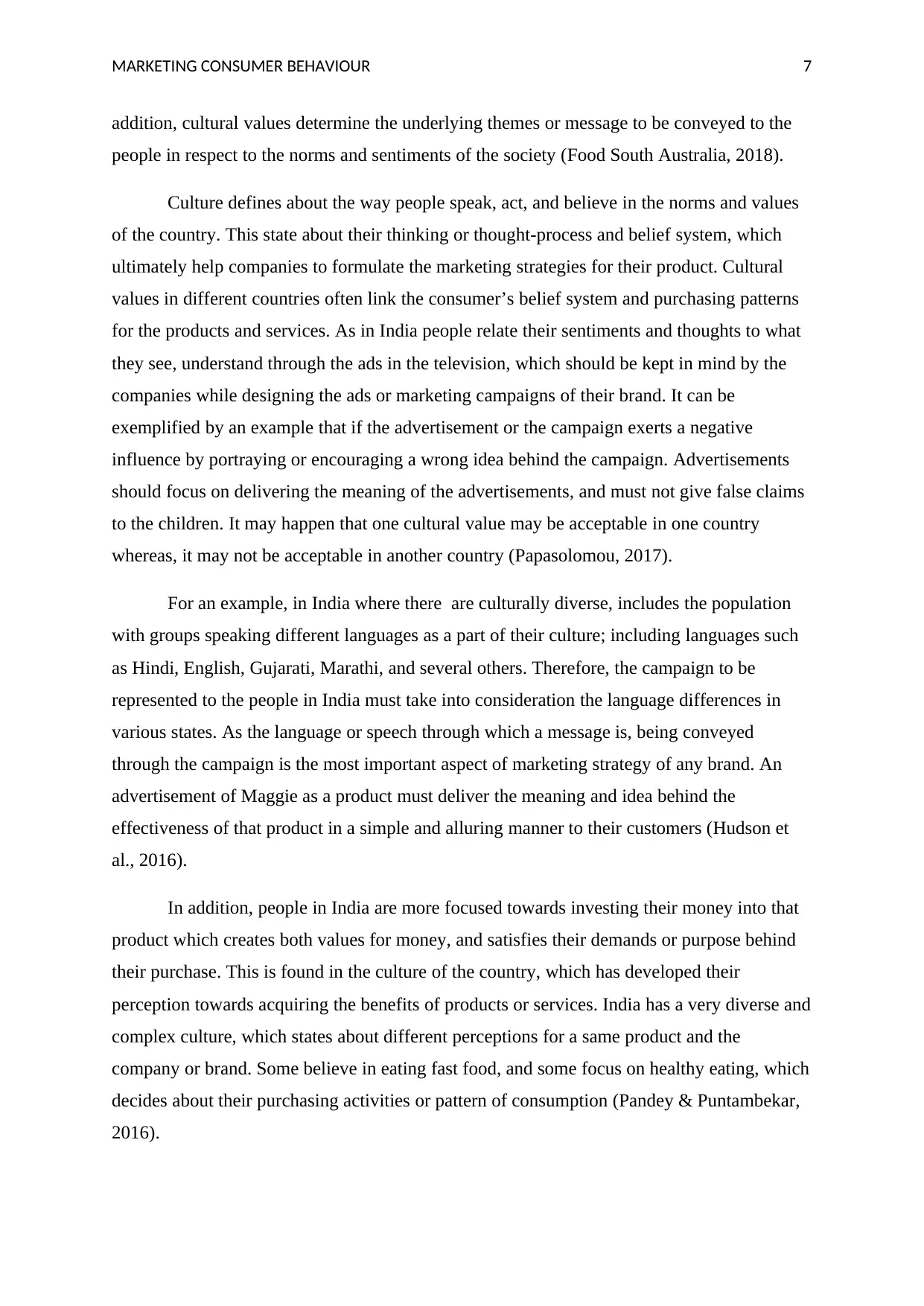
MARKETING CONSUMER BEHAVIOUR 7
addition, cultural values determine the underlying themes or message to be conveyed to the
people in respect to the norms and sentiments of the society (Food South Australia, 2018).
Culture defines about the way people speak, act, and believe in the norms and values
of the country. This state about their thinking or thought-process and belief system, which
ultimately help companies to formulate the marketing strategies for their product. Cultural
values in different countries often link the consumer’s belief system and purchasing patterns
for the products and services. As in India people relate their sentiments and thoughts to what
they see, understand through the ads in the television, which should be kept in mind by the
companies while designing the ads or marketing campaigns of their brand. It can be
exemplified by an example that if the advertisement or the campaign exerts a negative
influence by portraying or encouraging a wrong idea behind the campaign. Advertisements
should focus on delivering the meaning of the advertisements, and must not give false claims
to the children. It may happen that one cultural value may be acceptable in one country
whereas, it may not be acceptable in another country (Papasolomou, 2017).
For an example, in India where there are culturally diverse, includes the population
with groups speaking different languages as a part of their culture; including languages such
as Hindi, English, Gujarati, Marathi, and several others. Therefore, the campaign to be
represented to the people in India must take into consideration the language differences in
various states. As the language or speech through which a message is, being conveyed
through the campaign is the most important aspect of marketing strategy of any brand. An
advertisement of Maggie as a product must deliver the meaning and idea behind the
effectiveness of that product in a simple and alluring manner to their customers (Hudson et
al., 2016).
In addition, people in India are more focused towards investing their money into that
product which creates both values for money, and satisfies their demands or purpose behind
their purchase. This is found in the culture of the country, which has developed their
perception towards acquiring the benefits of products or services. India has a very diverse and
complex culture, which states about different perceptions for a same product and the
company or brand. Some believe in eating fast food, and some focus on healthy eating, which
decides about their purchasing activities or pattern of consumption (Pandey & Puntambekar,
2016).
addition, cultural values determine the underlying themes or message to be conveyed to the
people in respect to the norms and sentiments of the society (Food South Australia, 2018).
Culture defines about the way people speak, act, and believe in the norms and values
of the country. This state about their thinking or thought-process and belief system, which
ultimately help companies to formulate the marketing strategies for their product. Cultural
values in different countries often link the consumer’s belief system and purchasing patterns
for the products and services. As in India people relate their sentiments and thoughts to what
they see, understand through the ads in the television, which should be kept in mind by the
companies while designing the ads or marketing campaigns of their brand. It can be
exemplified by an example that if the advertisement or the campaign exerts a negative
influence by portraying or encouraging a wrong idea behind the campaign. Advertisements
should focus on delivering the meaning of the advertisements, and must not give false claims
to the children. It may happen that one cultural value may be acceptable in one country
whereas, it may not be acceptable in another country (Papasolomou, 2017).
For an example, in India where there are culturally diverse, includes the population
with groups speaking different languages as a part of their culture; including languages such
as Hindi, English, Gujarati, Marathi, and several others. Therefore, the campaign to be
represented to the people in India must take into consideration the language differences in
various states. As the language or speech through which a message is, being conveyed
through the campaign is the most important aspect of marketing strategy of any brand. An
advertisement of Maggie as a product must deliver the meaning and idea behind the
effectiveness of that product in a simple and alluring manner to their customers (Hudson et
al., 2016).
In addition, people in India are more focused towards investing their money into that
product which creates both values for money, and satisfies their demands or purpose behind
their purchase. This is found in the culture of the country, which has developed their
perception towards acquiring the benefits of products or services. India has a very diverse and
complex culture, which states about different perceptions for a same product and the
company or brand. Some believe in eating fast food, and some focus on healthy eating, which
decides about their purchasing activities or pattern of consumption (Pandey & Puntambekar,
2016).
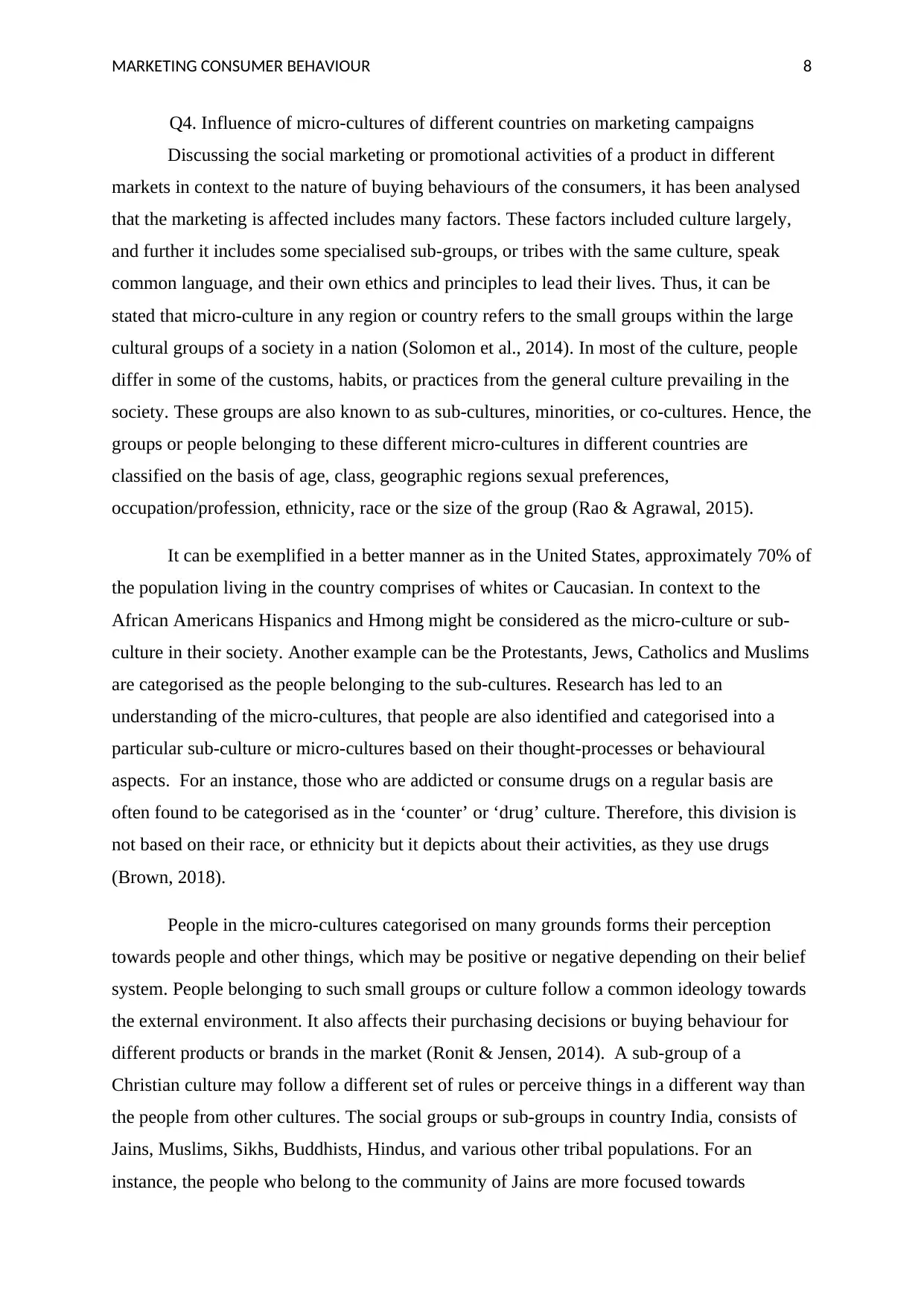
MARKETING CONSUMER BEHAVIOUR 8
Q4. Influence of micro-cultures of different countries on marketing campaigns
Discussing the social marketing or promotional activities of a product in different
markets in context to the nature of buying behaviours of the consumers, it has been analysed
that the marketing is affected includes many factors. These factors included culture largely,
and further it includes some specialised sub-groups, or tribes with the same culture, speak
common language, and their own ethics and principles to lead their lives. Thus, it can be
stated that micro-culture in any region or country refers to the small groups within the large
cultural groups of a society in a nation (Solomon et al., 2014). In most of the culture, people
differ in some of the customs, habits, or practices from the general culture prevailing in the
society. These groups are also known to as sub-cultures, minorities, or co-cultures. Hence, the
groups or people belonging to these different micro-cultures in different countries are
classified on the basis of age, class, geographic regions sexual preferences,
occupation/profession, ethnicity, race or the size of the group (Rao & Agrawal, 2015).
It can be exemplified in a better manner as in the United States, approximately 70% of
the population living in the country comprises of whites or Caucasian. In context to the
African Americans Hispanics and Hmong might be considered as the micro-culture or sub-
culture in their society. Another example can be the Protestants, Jews, Catholics and Muslims
are categorised as the people belonging to the sub-cultures. Research has led to an
understanding of the micro-cultures, that people are also identified and categorised into a
particular sub-culture or micro-cultures based on their thought-processes or behavioural
aspects. For an instance, those who are addicted or consume drugs on a regular basis are
often found to be categorised as in the ‘counter’ or ‘drug’ culture. Therefore, this division is
not based on their race, or ethnicity but it depicts about their activities, as they use drugs
(Brown, 2018).
People in the micro-cultures categorised on many grounds forms their perception
towards people and other things, which may be positive or negative depending on their belief
system. People belonging to such small groups or culture follow a common ideology towards
the external environment. It also affects their purchasing decisions or buying behaviour for
different products or brands in the market (Ronit & Jensen, 2014). A sub-group of a
Christian culture may follow a different set of rules or perceive things in a different way than
the people from other cultures. The social groups or sub-groups in country India, consists of
Jains, Muslims, Sikhs, Buddhists, Hindus, and various other tribal populations. For an
instance, the people who belong to the community of Jains are more focused towards
Q4. Influence of micro-cultures of different countries on marketing campaigns
Discussing the social marketing or promotional activities of a product in different
markets in context to the nature of buying behaviours of the consumers, it has been analysed
that the marketing is affected includes many factors. These factors included culture largely,
and further it includes some specialised sub-groups, or tribes with the same culture, speak
common language, and their own ethics and principles to lead their lives. Thus, it can be
stated that micro-culture in any region or country refers to the small groups within the large
cultural groups of a society in a nation (Solomon et al., 2014). In most of the culture, people
differ in some of the customs, habits, or practices from the general culture prevailing in the
society. These groups are also known to as sub-cultures, minorities, or co-cultures. Hence, the
groups or people belonging to these different micro-cultures in different countries are
classified on the basis of age, class, geographic regions sexual preferences,
occupation/profession, ethnicity, race or the size of the group (Rao & Agrawal, 2015).
It can be exemplified in a better manner as in the United States, approximately 70% of
the population living in the country comprises of whites or Caucasian. In context to the
African Americans Hispanics and Hmong might be considered as the micro-culture or sub-
culture in their society. Another example can be the Protestants, Jews, Catholics and Muslims
are categorised as the people belonging to the sub-cultures. Research has led to an
understanding of the micro-cultures, that people are also identified and categorised into a
particular sub-culture or micro-cultures based on their thought-processes or behavioural
aspects. For an instance, those who are addicted or consume drugs on a regular basis are
often found to be categorised as in the ‘counter’ or ‘drug’ culture. Therefore, this division is
not based on their race, or ethnicity but it depicts about their activities, as they use drugs
(Brown, 2018).
People in the micro-cultures categorised on many grounds forms their perception
towards people and other things, which may be positive or negative depending on their belief
system. People belonging to such small groups or culture follow a common ideology towards
the external environment. It also affects their purchasing decisions or buying behaviour for
different products or brands in the market (Ronit & Jensen, 2014). A sub-group of a
Christian culture may follow a different set of rules or perceive things in a different way than
the people from other cultures. The social groups or sub-groups in country India, consists of
Jains, Muslims, Sikhs, Buddhists, Hindus, and various other tribal populations. For an
instance, the people who belong to the community of Jains are more focused towards
⊘ This is a preview!⊘
Do you want full access?
Subscribe today to unlock all pages.

Trusted by 1+ million students worldwide
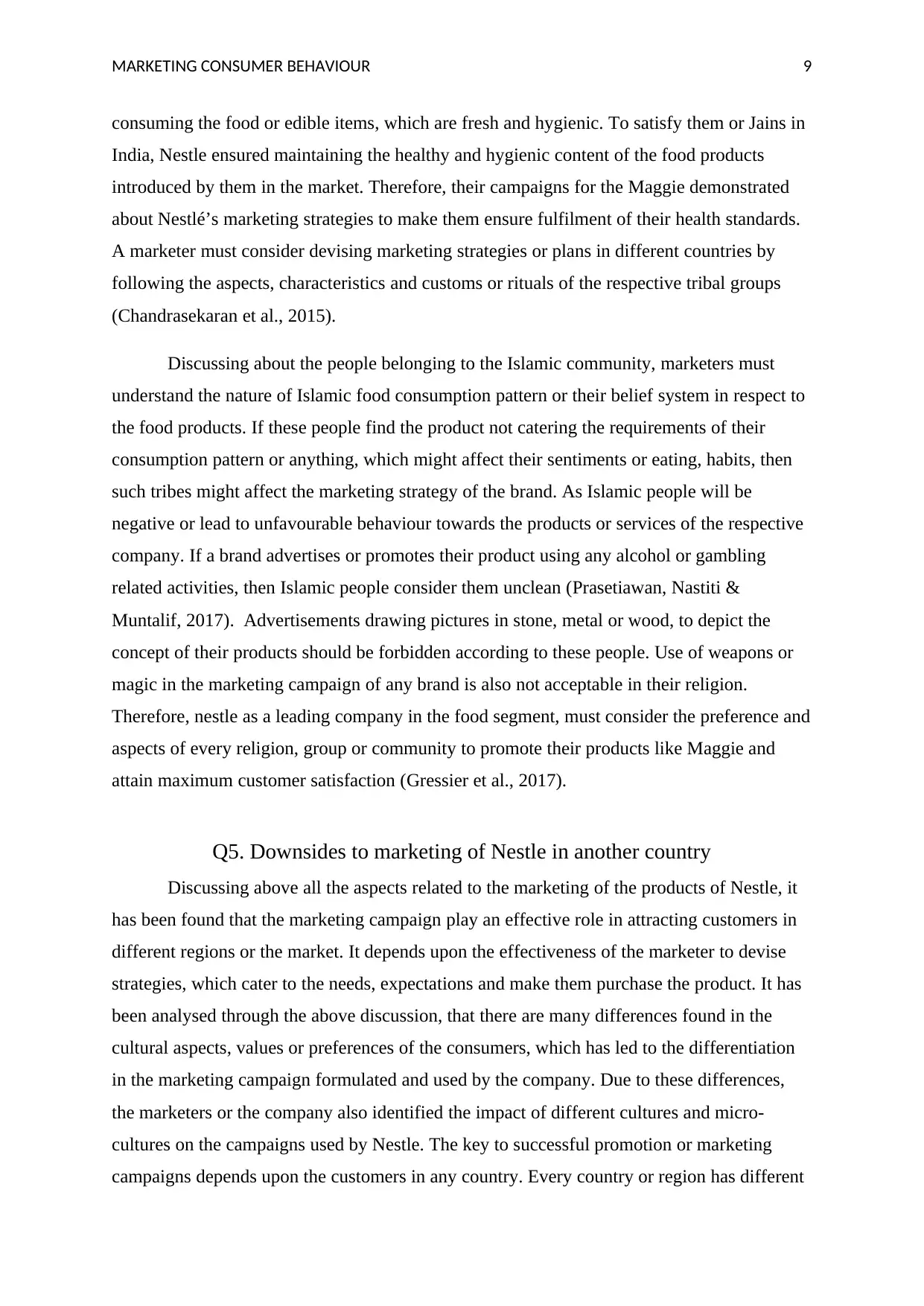
MARKETING CONSUMER BEHAVIOUR 9
consuming the food or edible items, which are fresh and hygienic. To satisfy them or Jains in
India, Nestle ensured maintaining the healthy and hygienic content of the food products
introduced by them in the market. Therefore, their campaigns for the Maggie demonstrated
about Nestlé’s marketing strategies to make them ensure fulfilment of their health standards.
A marketer must consider devising marketing strategies or plans in different countries by
following the aspects, characteristics and customs or rituals of the respective tribal groups
(Chandrasekaran et al., 2015).
Discussing about the people belonging to the Islamic community, marketers must
understand the nature of Islamic food consumption pattern or their belief system in respect to
the food products. If these people find the product not catering the requirements of their
consumption pattern or anything, which might affect their sentiments or eating, habits, then
such tribes might affect the marketing strategy of the brand. As Islamic people will be
negative or lead to unfavourable behaviour towards the products or services of the respective
company. If a brand advertises or promotes their product using any alcohol or gambling
related activities, then Islamic people consider them unclean (Prasetiawan, Nastiti &
Muntalif, 2017). Advertisements drawing pictures in stone, metal or wood, to depict the
concept of their products should be forbidden according to these people. Use of weapons or
magic in the marketing campaign of any brand is also not acceptable in their religion.
Therefore, nestle as a leading company in the food segment, must consider the preference and
aspects of every religion, group or community to promote their products like Maggie and
attain maximum customer satisfaction (Gressier et al., 2017).
Q5. Downsides to marketing of Nestle in another country
Discussing above all the aspects related to the marketing of the products of Nestle, it
has been found that the marketing campaign play an effective role in attracting customers in
different regions or the market. It depends upon the effectiveness of the marketer to devise
strategies, which cater to the needs, expectations and make them purchase the product. It has
been analysed through the above discussion, that there are many differences found in the
cultural aspects, values or preferences of the consumers, which has led to the differentiation
in the marketing campaign formulated and used by the company. Due to these differences,
the marketers or the company also identified the impact of different cultures and micro-
cultures on the campaigns used by Nestle. The key to successful promotion or marketing
campaigns depends upon the customers in any country. Every country or region has different
consuming the food or edible items, which are fresh and hygienic. To satisfy them or Jains in
India, Nestle ensured maintaining the healthy and hygienic content of the food products
introduced by them in the market. Therefore, their campaigns for the Maggie demonstrated
about Nestlé’s marketing strategies to make them ensure fulfilment of their health standards.
A marketer must consider devising marketing strategies or plans in different countries by
following the aspects, characteristics and customs or rituals of the respective tribal groups
(Chandrasekaran et al., 2015).
Discussing about the people belonging to the Islamic community, marketers must
understand the nature of Islamic food consumption pattern or their belief system in respect to
the food products. If these people find the product not catering the requirements of their
consumption pattern or anything, which might affect their sentiments or eating, habits, then
such tribes might affect the marketing strategy of the brand. As Islamic people will be
negative or lead to unfavourable behaviour towards the products or services of the respective
company. If a brand advertises or promotes their product using any alcohol or gambling
related activities, then Islamic people consider them unclean (Prasetiawan, Nastiti &
Muntalif, 2017). Advertisements drawing pictures in stone, metal or wood, to depict the
concept of their products should be forbidden according to these people. Use of weapons or
magic in the marketing campaign of any brand is also not acceptable in their religion.
Therefore, nestle as a leading company in the food segment, must consider the preference and
aspects of every religion, group or community to promote their products like Maggie and
attain maximum customer satisfaction (Gressier et al., 2017).
Q5. Downsides to marketing of Nestle in another country
Discussing above all the aspects related to the marketing of the products of Nestle, it
has been found that the marketing campaign play an effective role in attracting customers in
different regions or the market. It depends upon the effectiveness of the marketer to devise
strategies, which cater to the needs, expectations and make them purchase the product. It has
been analysed through the above discussion, that there are many differences found in the
cultural aspects, values or preferences of the consumers, which has led to the differentiation
in the marketing campaign formulated and used by the company. Due to these differences,
the marketers or the company also identified the impact of different cultures and micro-
cultures on the campaigns used by Nestle. The key to successful promotion or marketing
campaigns depends upon the customers in any country. Every country or region has different
Paraphrase This Document
Need a fresh take? Get an instant paraphrase of this document with our AI Paraphraser
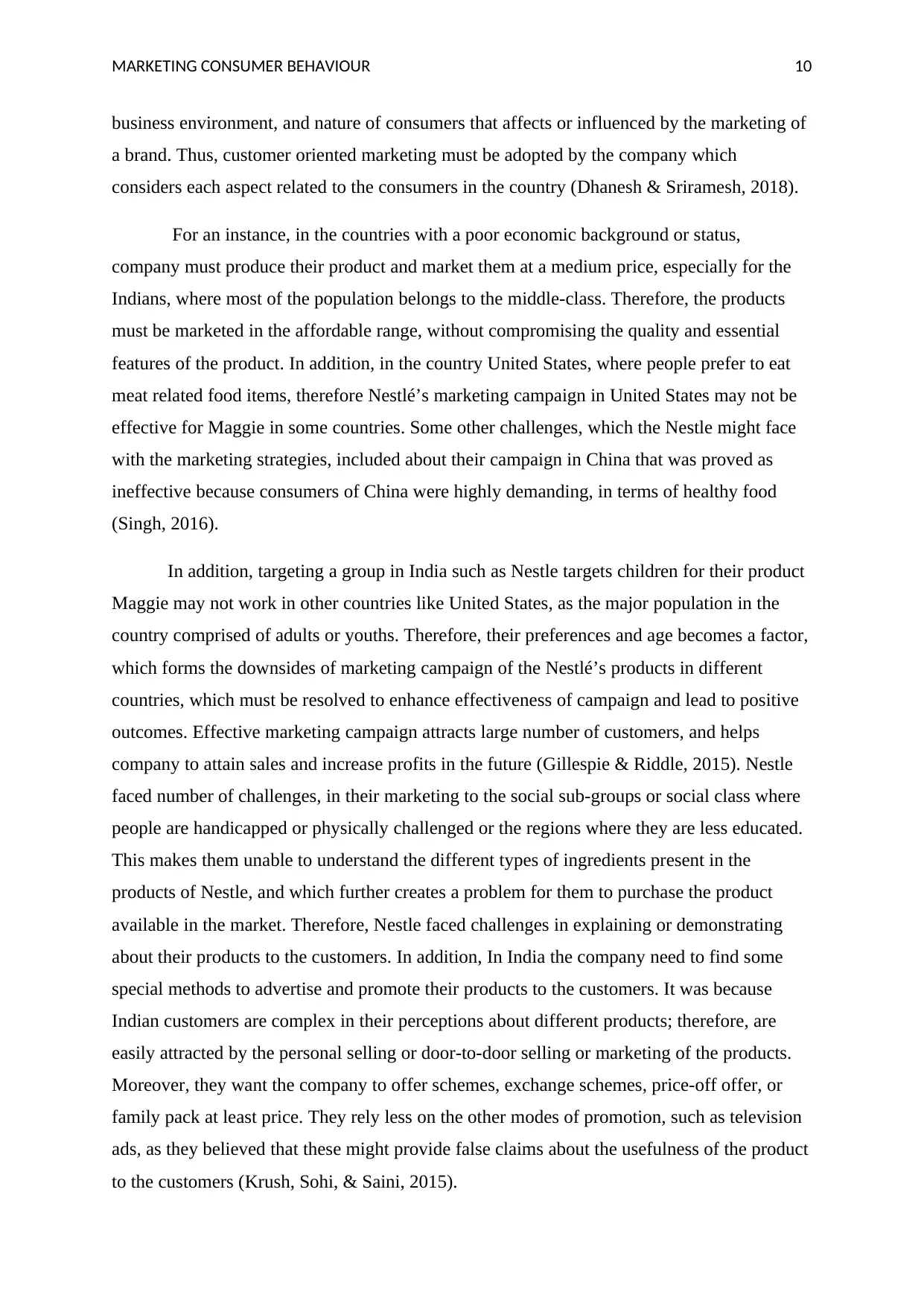
MARKETING CONSUMER BEHAVIOUR 10
business environment, and nature of consumers that affects or influenced by the marketing of
a brand. Thus, customer oriented marketing must be adopted by the company which
considers each aspect related to the consumers in the country (Dhanesh & Sriramesh, 2018).
For an instance, in the countries with a poor economic background or status,
company must produce their product and market them at a medium price, especially for the
Indians, where most of the population belongs to the middle-class. Therefore, the products
must be marketed in the affordable range, without compromising the quality and essential
features of the product. In addition, in the country United States, where people prefer to eat
meat related food items, therefore Nestlé’s marketing campaign in United States may not be
effective for Maggie in some countries. Some other challenges, which the Nestle might face
with the marketing strategies, included about their campaign in China that was proved as
ineffective because consumers of China were highly demanding, in terms of healthy food
(Singh, 2016).
In addition, targeting a group in India such as Nestle targets children for their product
Maggie may not work in other countries like United States, as the major population in the
country comprised of adults or youths. Therefore, their preferences and age becomes a factor,
which forms the downsides of marketing campaign of the Nestlé’s products in different
countries, which must be resolved to enhance effectiveness of campaign and lead to positive
outcomes. Effective marketing campaign attracts large number of customers, and helps
company to attain sales and increase profits in the future (Gillespie & Riddle, 2015). Nestle
faced number of challenges, in their marketing to the social sub-groups or social class where
people are handicapped or physically challenged or the regions where they are less educated.
This makes them unable to understand the different types of ingredients present in the
products of Nestle, and which further creates a problem for them to purchase the product
available in the market. Therefore, Nestle faced challenges in explaining or demonstrating
about their products to the customers. In addition, In India the company need to find some
special methods to advertise and promote their products to the customers. It was because
Indian customers are complex in their perceptions about different products; therefore, are
easily attracted by the personal selling or door-to-door selling or marketing of the products.
Moreover, they want the company to offer schemes, exchange schemes, price-off offer, or
family pack at least price. They rely less on the other modes of promotion, such as television
ads, as they believed that these might provide false claims about the usefulness of the product
to the customers (Krush, Sohi, & Saini, 2015).
business environment, and nature of consumers that affects or influenced by the marketing of
a brand. Thus, customer oriented marketing must be adopted by the company which
considers each aspect related to the consumers in the country (Dhanesh & Sriramesh, 2018).
For an instance, in the countries with a poor economic background or status,
company must produce their product and market them at a medium price, especially for the
Indians, where most of the population belongs to the middle-class. Therefore, the products
must be marketed in the affordable range, without compromising the quality and essential
features of the product. In addition, in the country United States, where people prefer to eat
meat related food items, therefore Nestlé’s marketing campaign in United States may not be
effective for Maggie in some countries. Some other challenges, which the Nestle might face
with the marketing strategies, included about their campaign in China that was proved as
ineffective because consumers of China were highly demanding, in terms of healthy food
(Singh, 2016).
In addition, targeting a group in India such as Nestle targets children for their product
Maggie may not work in other countries like United States, as the major population in the
country comprised of adults or youths. Therefore, their preferences and age becomes a factor,
which forms the downsides of marketing campaign of the Nestlé’s products in different
countries, which must be resolved to enhance effectiveness of campaign and lead to positive
outcomes. Effective marketing campaign attracts large number of customers, and helps
company to attain sales and increase profits in the future (Gillespie & Riddle, 2015). Nestle
faced number of challenges, in their marketing to the social sub-groups or social class where
people are handicapped or physically challenged or the regions where they are less educated.
This makes them unable to understand the different types of ingredients present in the
products of Nestle, and which further creates a problem for them to purchase the product
available in the market. Therefore, Nestle faced challenges in explaining or demonstrating
about their products to the customers. In addition, In India the company need to find some
special methods to advertise and promote their products to the customers. It was because
Indian customers are complex in their perceptions about different products; therefore, are
easily attracted by the personal selling or door-to-door selling or marketing of the products.
Moreover, they want the company to offer schemes, exchange schemes, price-off offer, or
family pack at least price. They rely less on the other modes of promotion, such as television
ads, as they believed that these might provide false claims about the usefulness of the product
to the customers (Krush, Sohi, & Saini, 2015).
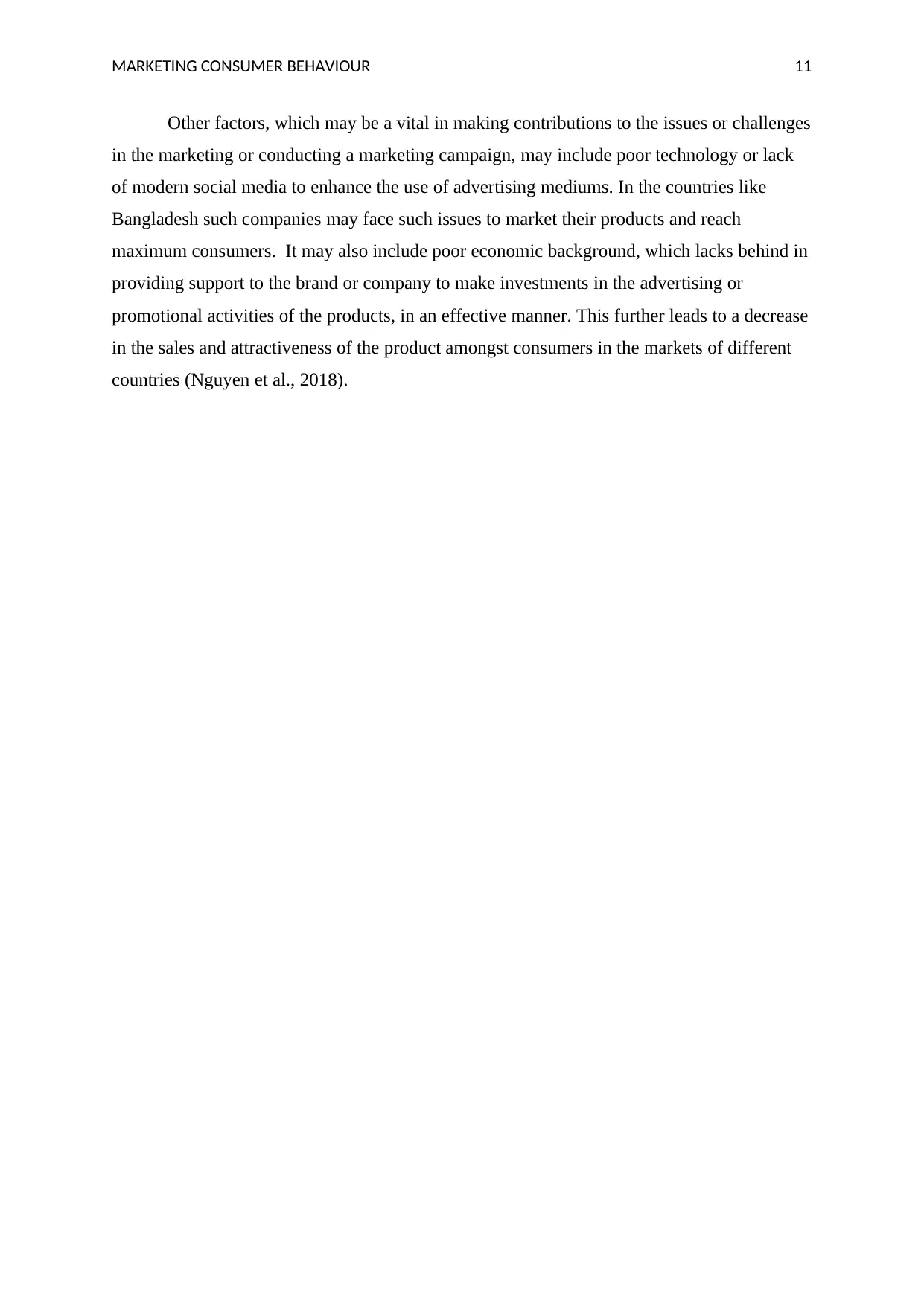
MARKETING CONSUMER BEHAVIOUR 11
Other factors, which may be a vital in making contributions to the issues or challenges
in the marketing or conducting a marketing campaign, may include poor technology or lack
of modern social media to enhance the use of advertising mediums. In the countries like
Bangladesh such companies may face such issues to market their products and reach
maximum consumers. It may also include poor economic background, which lacks behind in
providing support to the brand or company to make investments in the advertising or
promotional activities of the products, in an effective manner. This further leads to a decrease
in the sales and attractiveness of the product amongst consumers in the markets of different
countries (Nguyen et al., 2018).
Other factors, which may be a vital in making contributions to the issues or challenges
in the marketing or conducting a marketing campaign, may include poor technology or lack
of modern social media to enhance the use of advertising mediums. In the countries like
Bangladesh such companies may face such issues to market their products and reach
maximum consumers. It may also include poor economic background, which lacks behind in
providing support to the brand or company to make investments in the advertising or
promotional activities of the products, in an effective manner. This further leads to a decrease
in the sales and attractiveness of the product amongst consumers in the markets of different
countries (Nguyen et al., 2018).
⊘ This is a preview!⊘
Do you want full access?
Subscribe today to unlock all pages.

Trusted by 1+ million students worldwide
1 out of 16
Related Documents
Your All-in-One AI-Powered Toolkit for Academic Success.
+13062052269
info@desklib.com
Available 24*7 on WhatsApp / Email
![[object Object]](/_next/static/media/star-bottom.7253800d.svg)
Unlock your academic potential
Copyright © 2020–2025 A2Z Services. All Rights Reserved. Developed and managed by ZUCOL.





